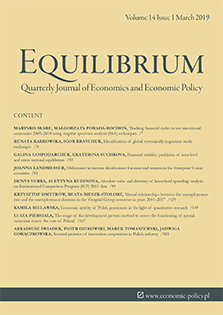Financial stability: problems of inter-level and cross-sectoral equilibrium
Financial stability: problems of inter-level and cross-sectoral equilibrium
Author(s): Galina Gospodarchuk, Ekaterina SuchkovaSubject(s): Economic policy, Financial Markets, Fiscal Politics / Budgeting
Published by: Instytut Badań Gospodarczych
Keywords: financial stability; indicators of financial stability; analysis of financial stability; instruments for regulating financial stability;
Summary/Abstract: Research background: As part of the creation of an effective mechanism for managing financial stability, the tasks of providing an inter-level and cross-sectoral financial equilibrium remain unresolved. So far, clear and unambiguous criteria for financial stability have not been formulated, with which monetary and prudential policies could be related, as well as measures to minimize systemic and individual risks. The problem of creating a system of indicators comes to the fore, allowing the creation of new effective instruments for regulation of financial flows that contribute to the prevention of financial crises. Purpose of the article: The paper proposes a system of indicators of financial stability, which allows for solving the tasks of inter-level and cross-sectoral equilibrium in the selection of regulatory tools for monetary and prudential policy. Methods: We have used real interest rates as a measure of financial stability at the macro level. The real rates have been calculated from time series with nominal interest rate and inflation in the credit market (divided into loans to financial and non-financial organizations and individuals), and in the bond market (divided into corporate, municipal, and federal bonds). The analysis of the market and institutional financial stability of the USA, Russia, Japan, Switzerland, Australia over the period 1984–2014 was done. Then, comprehensive investigation on the financial stability in the Russian Federation in 2014–2017 was conducted. The results have been compared against financial stability of individual banks, which was measured using profit to risk ratio. The latter has been calculated from bank’s financial reports using our method, which had been developed earlier. Findings & Value added: We have developed criteria for qualitative assessment of financial stability and the risk map, which helps to identify the level of accumulated imbalances in the market and institutional environment, as well as in the levels and sectors of the economy. The criteria for selecting monetary and prudential regulatory instruments have been formulated depending on the amount of accumulated risks. The criteria for forming a portfolio of regulatory instruments with regard to their rigidity are proposed.
Journal: Equilibrium. Quarterly Journal of Economics and Economic Policy
- Issue Year: 14/2019
- Issue No: 1
- Page Range: 53-79
- Page Count: 27
- Language: English

